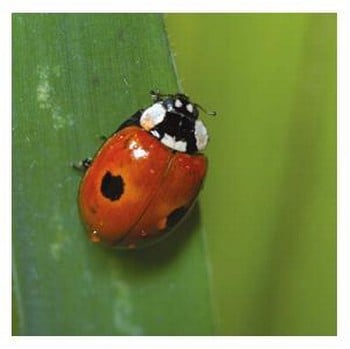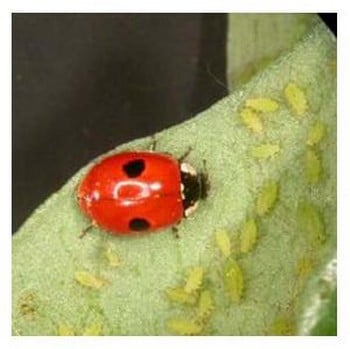Aphid Control using Ladybirds is something that nature came up with a very long time ago and as usual, nature knows best - and that's why introducing adult ladybirds into the garden to help in the constant battle against greenfly and blackfly is proving very popular and effective.
Aphid Control using Ladybirds uses adult ladybirds (adalia bipunctata) - very effective predators of aphids - for indoor control, where in a contained environment such as a greenhouse or conservatory they can eat up to 5,000 aphids in their lifespan!
Aphid Control using Ladybirds arrives with you in the shape of a simple-to-use shaker tube containing 25 adult ladybirds and application could not be easier; just tap the tube onto leaves of affected plants and let the ladybirds get munching!
PLEASE NOTE: the pest MUST be present before introducing this predator for control to be effective - please do not order beforehand. This live product is despatched to UK addresses only!
Aphid Control using Ladybirds supplied in a shaker tube containing 25 adults
- Use for indoor infestations
- Aphid Control using Ladybird Larvae best suited for outdoor use
- Aphid Control using Ladybirds ideal for controlled environment such as a greenhouse or conservatory
- Simply shake adults onto leaves of affected plants
- Ideal for use on larger, taller plants as adult ladybirds are mobile
- Sap sucking aphids are vectors of plant viruses
- Adult ladybirds can consume as many as 5000 aphids in a lifetime
- Aphids also known as greenfly or blackfly
- Ideal for light aphid infestations - try Aphid Kill using Lacewing Larvae for major aphid problems

Live Pest Control Delivery
Being a live product the ladybirds are ordered weekly every Thursday. These are then delivered on Wednesday of the following week for delivery by the end of the week.
For example an order placed on a Monday would be ordered on Thursday, received the following Wednesday for delivery by the end of that week.

Product Reviews
I released the ladybirds into my greenhouse which had a moderate aphid infestation. Within 48 hours all ladybirds had vanished (presumably through windows), and there had been no noticeable effect on the aphids. Completely useless, waste of money!
Many thanks for your feedback. The ladybirds should ideally be released onto the infested plants and if possible keep the windows shut for a day or two! This shouldn't be necessary but by placing one of the aphid infested leaves into the container so the ladybirds are confronted directly with their prey can kick start them into attacking / eating mode. They would then probably emerge from the container foraging rather than dispersing out of any open windows. It is possible they are still present, just sitting dormant in one of the many nooks in the greenhouse framework. Kind Regards Gavin Hatt Pest Control Expert
Bought these as a replacement for the discontinued Parasitic Wasps I had been using Savona but there was a major infestation in the greenhouse, and although pricey I decided to try them out as I prefer to avoid chemical use on my crops. I am glad I spent the money, they are fantastic, especially combined with Lacewing Larvae, I have not seen any aphids in my greenhouse for weeks now and the a few ladybirds are still there doing their job. Highly Recommended.
APHIDS
Order; Hemiptera
Family; Aphididae
Symptoms
The presence of the 500 species of aphid is indicated by large amounts of sticky honeydew and sooty moulds on the upper surfaces of leaves. Aphids are extremely well-known to gardeners under the guise of greenfly, blackfly and various local names. As well as the above symptoms, the effects of aphids feeding on plant material weakens and distorts new growth, and these pests will also spread viruses from diseased plants to healthy plants through their saliva. Aphids are clearly visible on the stems and leaves of infested plants, and the mosaic patterns of the various viruses they transmit can also be seen on the leaves. Many of the hundreds of species of aphids are common pests of fruits, vegetables and outdoor ornamental plants as well as greenhouse and house plants. Some species will feed exclusively on one plant species but others will attack hundreds of different plant hosts.
Description and Life Cycle
All species of aphids can be found on plant stems and leaves of the host plant. These small soft-bodied insects range in size from 0.5mm to 6.5mm in length, and colours can vary from shades of green to black, yellow, brown, pink, grey and white. Unfortunately for the gardener, aphids have the ability to produce live young from unimpregnated females although the reproduction of this pest is complicated by seasonal alternation of sexual and asexual periods of development and the differences between the hundreds of species. Some aphids are winged and although they cannot fly as such, they can be carried hundreds of miles on thermal breezes, leading to further infestations. Generally, eggs are laid in the autumn on the winter host plant which hatch in the spring; this is followed by migration to the summer host plant (hence the species peach-potato aphid). Another generation is produced in the autumn which returns to the winter host for egg production.
Biological Pest Control Treatment
The coccinellidae family (more commonly known as ladybird beetles) are well known as beneficial garden predators. There are various species of ladybird but most will feed on aphids, and some species will also attack scale insects, mites, mealybugs and whitefly. It is good horticultural practice to encourage ladybirds into the garden and greenhouse environment as they will attack any aphids in the margins and will also move into an adjacent area when infestations of aphids appear. Generally the eggs of the various ladybird species are laid on the underside of leaves in spring. The adults overwinter in buildings or under bark so the provision of a ladybird nest or bug box will help to keep numbers of overwintering adults high. The larvae which eventually hatch from the eggs are mobile and benefit from having the same biting jaws as adults, and are in fact, more voracious feeders than the adults when almost fully grown. The larvae pupate either in close proximity to their main food source or in a simple pupal case on the ground.Occasionally, ants may be seen swarming over aphid populations on the stems of plants; these ants are actually feeding on the honeydew secreted by the aphids and are not consuming the pests.
Live Pest Control Delivery
Being a live product the ladybirds are ordered weekly every Thursday. These are then delivered on Wednesday of the following week for delivery by the end of the week.
For example an order placed on a Monday would be ordered on Thursday, received the following





























